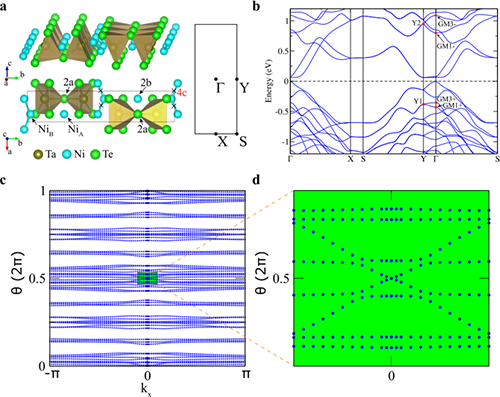Quadrupole topological insulators in Ta2M3Te5 (M=Pd, Ni) monolayers
Date:14-02-2023 Print
In higher-order topological insulators, the ingap states can be found in (d-n)-dimensional edges (n > 1), such as the corner states of two-dimensional (2D) systems or the hinge states of three-dimensional systems. Higher-order topological insulators have been introduced in the precursory Benalcazar-Bernevig-Hughes quadrupole model [1], but no electronic compound has been proposed to be a quadrupole topological insulator (QTI) yet. In recent years, van der Waals layered materials of A2M1,3Te5 (A=Ta, Nb; M=Pd, Ni; X=Se, Te) family have attracted attentions because of their special properties, such as quantum spin Hall effect in Ta2Pd3Te5 monolayer [2], excitonic state in Ta2NiSe5, and superconductivity in Nb2Pd3Te5. In particular, the monolayers of A2M1,3Te5 family can be exfoliated easily, serving as a good platform for studying topology and interactions in lower dimensions.
Recently, the research group of Prof. Zhijun Wang, Drs. Zhaopeng Guo, Junze Deng, and Yue Xie from Institute of Physics of the Chinese Academy of Sciences reported that Ta2Ni3Te5 monolayer can be 2D QTI with second-order topology due to the double-band inversion [3]. A time-reversal-invariant system with two mirror reflections (Mx and My) can be classified by Stiefel-Whitney numbers (w1, w2) due to the combined symmetry TC2z. Using the Wilson loop method (Figure 1), we compute w1 = 0 and w2 = 1 for Ta2Ni3Te5, indicating a QTI with qxy = e/2. Thus, gapped edge states and localized corner states are obtained. By analyzing atomic band representations, we demonstrate that its unconventional nature with an essential band representation at an empty site, i.e., Ag@4e, is due to the remarkable double-band inversion on Y-Γ with elementary band representations of A'@4e (Ta-dz2) and A''@4e (Te-px). Then, we construct an eight-band quadrupole model with Mx and My successfully for electronic materials, and confirm the higher-order topology (Figure 2). These transition-metal compounds of A2M1,3Te5 (A=Ta, Nb; M=Pd, Ni; X=Se, Te) family provide a good platform for realizing the QTI and exploring the interplay between topology and interactions.

Figure 1, Electron structures of Ta2Ni3Te5 monolayer. (a) crystal structure (b) band structure and (c-d) Wilson loop spectrum.

Figure 2, (a-d) Edge states and corner states of eight-band tight-binding model. (e) The physical properties of A2M1,3Te5 family.
This study entitled "Quadrupole topological insulators in Ta2M3Te5 (M=Pd, Ni) monolayers" was published on npj Quantum Materials 7, 87 (2022).
This work was supported by the National Natural Science Foundation of China, the Strategic Priority Research Program of Chinese Academy of Sciences, the China Postdoctoral Science Foundation funded project, and the Center for Materials Genome.
Relate link: https://www.nature.com/articles/s41535-022-00498-8
Contact
Institute of Physics, Chinese Academy of Sciences
Zhijun Wang
Email: wzj@iphy.ac.cn
Key words:
Topological materials, higher-order topology, low dimension.
Abstract:
Ta2Ni3Te5 monolayer can be 2D QTI with second-order topology due to the double-band inversion. Its unconventional nature with an essential band representation at an empty site, i.e., Ag@4e, is due to the remarkable double-band inversion on Y-Γ with band represents of A'@4e (Ta-dz2) and A''@4e (Te-px).
Reference
[1] W. Benalcazar, B.Bernevig, and T.Hughes, Science 357,61-66 (2017)
[2] Z.Guo, D.Yan, H.Sheng, S.Nie, Y.Shi, and Z.Wang, Phys. Rev. B 103,115145 (2021)
[3] Z.Guo, J.Deng, Y.Xie, and Z.Wang, npj Quantum Mater. 7, 87 (2022)

